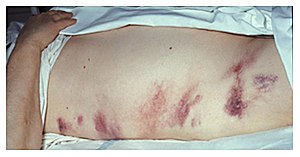Grey Turner's sign
Jump to navigation
Jump to search
| Grey Turner's sign | |
|---|---|
 | |
| Grey Turner's sign | |
| Causes | Acute pancreatitis, ectopic pregnancy |
Grey Turner's sign refers to bruising of the flanks, the part of the body between the last rib and the top of the hip. The bruising appears as a blue discoloration,[1] and is a sign of retroperitoneal hemorrhage, or bleeding behind the peritoneum, which is a lining of the abdominal cavity. Grey Turner's sign takes 24–48 hours to develop, and can predict a severe attack of acute pancreatitis.[2]
Grey Turner's sign may be accompanied by Cullen's sign. Both signs may be indicative of pancreatic necrosis with retroperitoneal or intra-abdominal bleeding.
It is named after British surgeon George Grey Turner.[3]
Causes
Causes include
- Acute pancreatitis, whereby methemalbumin formed from digested blood tracks subcutaneously around the abdomen from the inflamed pancreas.
- Pancreatic hemorrhage[1]
- Retroperitoneal hemorrhage[1]
- Blunt abdominal trauma
- Ruptured / hemorrhagic ectopic pregnancy.
- Spontaneous bleeding secondary to coagulopathy (congenital or acquired)
- Aortic rupture, from ruptured abdominal aortic aneurysm or other causes.[1]
History
It is named after British surgeon George Grey Turner.[3][4]
References
- ↑ 1.0 1.1 1.2 1.3 Goldman, Lee (2012). Goldman's Cecil Medicine (24th ed.). Philadelphia: Elsevier Saunders. p. 837. ISBN 978-1437727883.
- ↑ Bosmann M, Schreiner O, Galle PR (April 2009). "Coexistence of Cullen's and Grey Turner's signs in acute pancreatitis". Am. J. Med. 122 (4): 333–4. doi:10.1016/j.amjmed.2008.08.032. PMID 19332225.
- ↑ 3.0 3.1 synd/3347 at Who Named It?
- ↑ Turner, G. Grey (1919). "Local discoloration of the abdominal wall as a sign of acute pancreatitis". British Journal of Surgery. 7 (27): 394–395. doi:10.1002/bjs.1800072711. S2CID 72710780. Archived from the original on 2019-12-08. Retrieved 2021-11-10.
External links
| Classification |
|---|